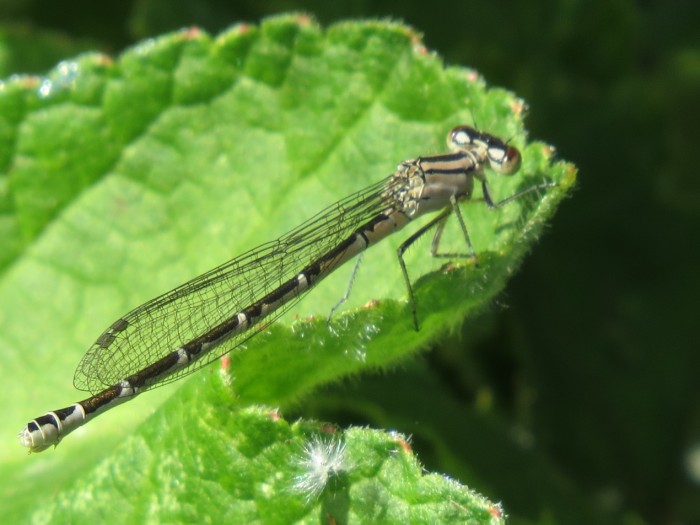Name
Enallagma cyathigerum (Charpentier, 1840)
Family:
Coenagrionidae
Status in Britain and Ireland:
common and widespread
Local Status:
common
Size:
Overall body length 29-36mm
Hindwing length 15-21mm
Flight period:
May until September
Photograph © G. Hiatt
Male Common Blue Damselfly
The body is blue. Broad antehumeral stripes are present on the top of the thorax and the sides are solid blue. On segment 2 there is a ‘lollipop’ shaped stalked black spot. Segments 8 and 9 are all blue and segment 10 is black. Eyes are blue and legs black. Wings are clear with a small black pterostigma.
Photograph © G. Hiatt
Female Common Blue Damselfly
There are 2 female forms, a drab green form that turns brown with age (shown above) and a blue form. In both forms black ‘rocket’ shapes extend along the abdominal segments and a black thistle shape is present on segment 2. A diagnostic spine is present under segment 8. Broad antehumeral stripes are present on the top of the thorax and the sides are solid colour with no spur present.
Similar Species
In Shropshire this species can be confused with Azure Damselfly and the far less common Variable Damselfly.
Male Azure Damselflies have a U shape on segment 2, a black bowtie shape on segment 9 and narrow antehumeral stripes. Male Variable Damselflies have a goblet shape on segment 2, a black bat shaped mark on segment 9 and narrow broken antehumeral stripes. Both Azure and Variable males also have a spur present on the side of the thorax.
Female Azure Damselflies and female Variable Damselflies do not have a spine present under segment 8. In addition they both have a spur on the side of the thorax which is absent in female Common Blue Damselfly.
Immature Common Blue Damselfly has a pale body and legs and may superficially look like White-legged Damselfly . The broad white tibia and feather like appearance of the White-legged Damselfly legs should however easily distinguish this species.
Behaviour
Often seen in great numbers on large water bodies and can be seen flying over water some distance from the bank. They are also found well away from water, often amongst tall vegetation from where they hunt for insects. Females will oviposit in tandem on surface vegetation and sometimes the female will submerge below the surface. Males remain on guard above and ‘rescue’ waterlogged females that are unable to escape the water surface-tension.
Habitat
Can be found in a wide variety of habitats from lakes, ponds, slow flowing rivers and streams. Seems to prefer larger bodies of water with tall marginal vegetation.
Shropshire Distribution
Historic records date back to 1917 at Bomere followed by a sighting at Whixall Moss in 1932. Records increased from the late 1950’s onwards and Butler (1982) described this species as ‘practically everywhere’ whilst Lockton et al., (1996) termed it ‘ubiquitous.’ This is the most widespread species in Britain and Ireland (Cham et al., 2014) and is found throughout Shropshire on all suitable waterbodies. The most current distribution maps show a great deal of infilling within the previously recorded range – most likely due to increased recorder effort.
Where to see in Shropshire
Numerous canals, ponds, lakes and meres throughout the county.




